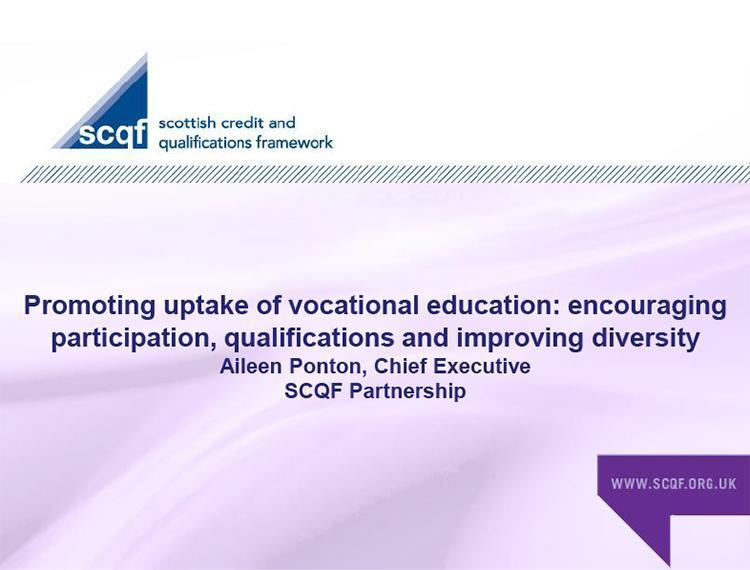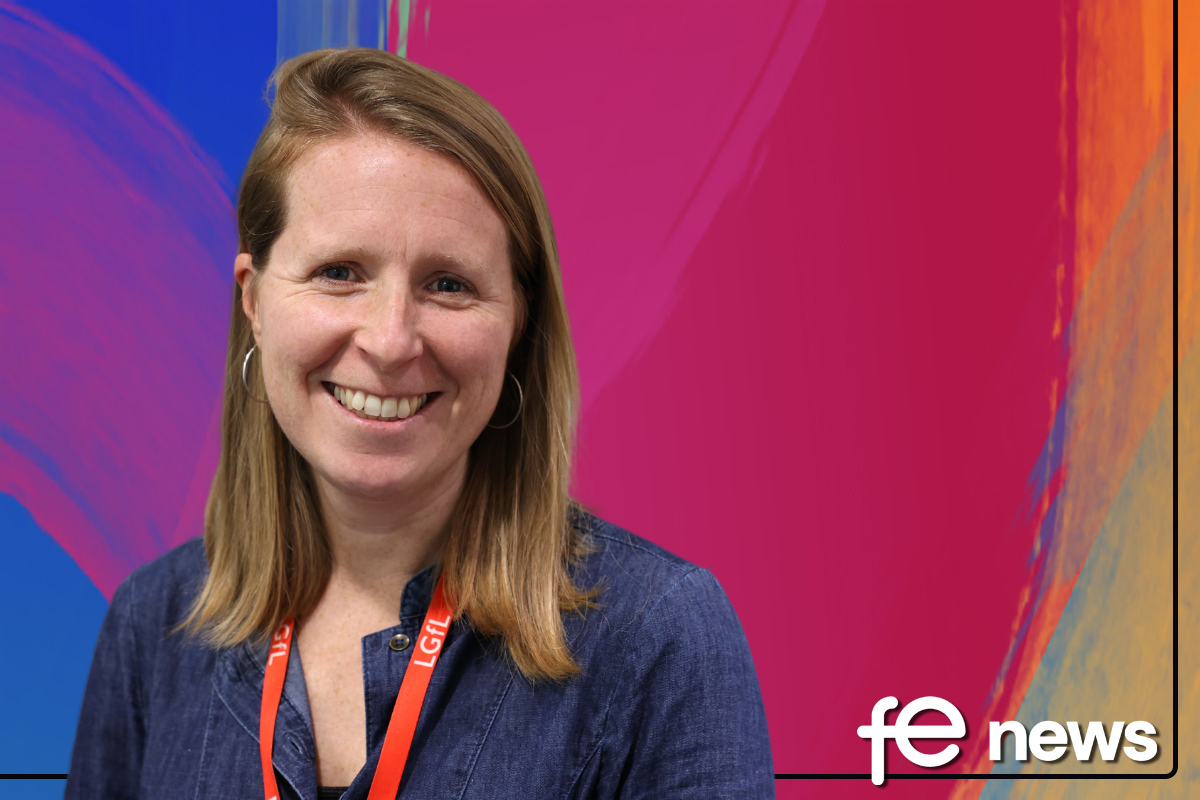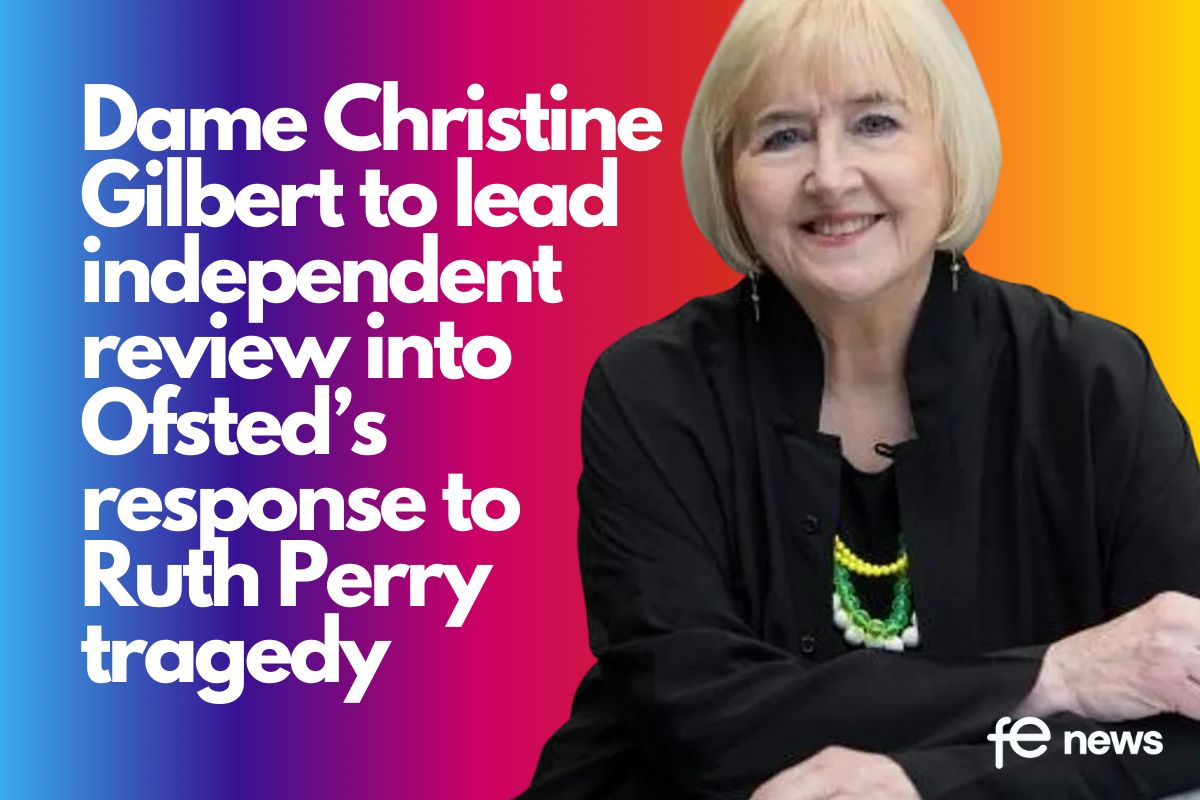Promoting uptake of vocational education: encouraging participation, qualifications and improving diversity

Probably 90% of my time is spent trying to make sure that people understand the pathways, progression routes and the multitude of qualifications that we have and that they are all fit for purpose, but sometimes those purposes are quite different.
What is the Scottish Credit and Qualifications Framework, and how does it support positive destinations?
What’s on the framework that actually is being used in terms of vocational pathways?
Obviously it is our lifelong learning framework, it does help people understand qualifications. It does help people plan their route through that. It has got its 12 levels and everything in Scotland that is a qualification that is formally recognised and assessed, can be on the framework and I’ll come in a minute to just what is there.
But it’s a way of helping people plan those journeys and, at the moment both the Government and also many other organisations are turning their minds to, “What do we mean by progression pathways and learner journeys?”. How do we actually engage with young people and adults to help them take more informed choices about what they want to do? Foundation apprenticeships are a big part of what’s on offer but there are other things.
How does SCQF Support Learners?
What more could we collectively be doing to promote a wider range of options in school, in college, in that learner journey?
So how does it support learners, it gives them recognition for a range of learning and skills, there’s a lot on the framework that people can recognise and identify with. It helps them understand the level of where they’re at, because sometimes that’s something… we have so many names for qualifications and over the years we’ve replaced, we’ve had O grades, we’ve had standard grades, we’ve had Int 1 and Int 2 and now we’ve got Nationals.
Employers have just as much difficulty as young people in understanding, well what does that actually mean? What level is that qualification and what does that mean in terms of the next step that I want to make or the next choice I want to make?
It can increase confidence and motivation. We’ve done a lot of work with young people particularly in community learning settings, where they have very little in the way of formal qualifications from school for all sorts of reasons, but who’ve actually not realised that some of the things that they’ve done through community based learning are on the framework, do have a level, do have a credit value and are being recognised.
And finally, it does avoid duplication of learning. The recent Learner Journey Review that the Scottish Government looked at, a lot of that was about those transitions from school and further education, from further education into higher education and into the workplace.
How do we make sure that we’re not asking people to repeat their learning, we’re not funding the repeat of learning? So we’re actually opening up the pathways and letting people make those choices based on the right qualification for them, and not the one that’s best funded.
At the moment sitting on the register, on the database that underpins the framework, there’s about 11,400 qualifications. So that’s a lot to understand and know and plot your way through and if you’re just one individual trying to make those choices about what’s the right next step for you, that can be quite daunting.
There are about 280 different organisations who own those qualifications, so we need to get out of the mindset of thinking that the only people who provide qualifications are our national qualification bodies or colleges or universities.
Employers have lots of their own training, really well quality assured, we’ve got lots in the community and development sector. There’s a whole range of things sitting within the framework that have been levelled and credit rated and therefore they have that quality assurance attached to them.
So more than 800, about 870 of those 11,000 qualifications are what I’d call sitting in the non-formal setting, owned by organisations outside of our kind of formal institutions. And one of the statistics I do like to use quite often is that more than 84% of qualifications at Level 6 are not Highers. So although Highers are a big thing and a big important product of what we have here in Scotland, actually there are more qualifications sitting at that same level that are not Highers.
What more could be done to promote a wider range of options?
When we are thinking about young people and their options and choices, do we as a community, does our careers setting, do our institutions, know, understand and value that range of things that sit there when they’re helping people to make a plan. And if you’re trying to make a plan through 11,500 qualifications, that’s tough for anyone, tough for an adult, I’d find it daunting. But for a young person at school, trying to cope with what their parent thinks, what their peer thinks and what their teacher thinks, how helpful is it going to be to move through that.
I’m just going to give you just a few examples, just to give you a sense of some of the things that are being used for example in senior phase:
- King George VI programme of leadership
- Duke of Edinburgh leadership programme
- Sports leadership programme
- Foundation apprenticeships
- Youth achievement awards
- Certificate of work readiness and
- Dynamic youth awards
All on the framework, all with a level on the SCQF, all with a credit value, all with a quality assurance in formal assessment sitting behind them.
Do we always value these? Do we always encourage people to engage with these? Or are we sometimes stuck in the rut of thinking about just how our mainstream qualifications work?
In terms of opportunities for promotion, I think the recent learner journey review threw up quite a lot of this. But I do think that we have to continue to develop the understanding of qualifications among learners, parents and schools, through better partnerships, more joined up simple messaging, a lack of jargon and a one stop shop for information.
We really need to make it easier for teachers and parents to understand and guide their young people in making those options and choices.
We have got a provision of clear pathways, we need to have strong partnerships between schools and other providers and we need staff in schools to have very easy access to this information and they tell us it’s a minefield sometimes to work out where is the place to go to get the right bit of information.
The school ambassador programme
DYW Glasgow did a #NoWrongPath hashtag earlier this year, it was a great success, that’s exactly the kind of message we have to give out. We’re also reviewing the insight tariff and which schools use in a way of trying to make sure that we are recognising and valuing those qualifications.
We’re wrapping a lot of that up in our schools ambassador programme which we launched last year to try and support schools; we’re working with 35 schools at the moment. We’re asking schools in terms of their senior staff and their teachers and guidance staff and their pupils, to help promote a better understanding of the SCQF in doing that.
In summary, we think that the framework does provide a lot of support. It explains how qualifications fit together; it helps people plan those journeys. We think that the move towards regional collaboration and regional curriculum planning is a good one, but we need to use the SCQF again to avoid the duplication under that.
We do have lots of information and promotion and guidance information for teachers, for the employers, for schools and for parents, and we’re always keen to engage with any organisation who thinks they can help get that message out.
Aileen Ponton, Chief Executive, SCQF Partnership












Responses